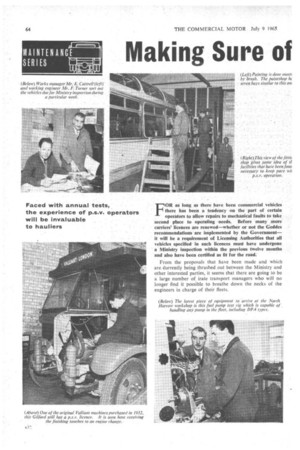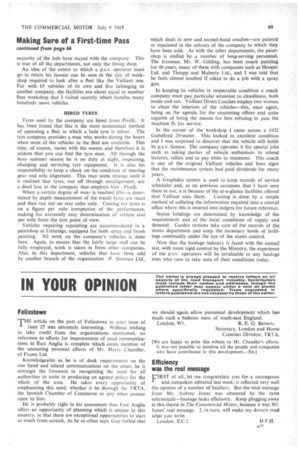Making Sure of First-time Pass
Page 66

Page 67

Page 68

Page 71

If you've noticed an error in this article please click here to report it so we can fix it.
By R. 0. CATER
AM instBE
• FOR as long as there have been commercial vehicles there has been a tendency on the part of certain operators to allow repairs to mechanical faults to take second place to operating -needs. Before manymore carriers' licences are renewed—whether or not the Geddes recornmendations are implemented by the Government— it will be a requirement of Licensing Authorities that all vehicles specified in such licences must have undergone a Ministry inspection within the previous twelve months and also have been certified as fit for the road:
From the proposals that have been made and which are Currently being thrashed out between the Ministry and other interested parties, it seems that there are going to be a large number of irate transport managers who will no longer find it possible to breathe down the necks of the engineers in charge of their fleets. The purpose of my visit to Valliant Direct Coaches was to enable me to produce a picture of what can be expected when the tests become necessary, and to show haulage operators how their passenger counterparts have catered for the annual needs of the Ministry.
One of the first points that was impressed upon me by Mr. E. Cottrell, works manager of the Valliant organization, was that if a vehicle was allowed to get into such a condition that it was possible for the area examiner to fault it, then invariably it was a long job to get cleared. As in haulage, a vehicle standing was not a vehicle earning, and time wasted awaiting clearance when the annual examination had produced a series of faults was simply nothing more than a waste of money. For this reason a very comprehensive system of servicing and periodic inspection has been devised by the company which takes the form of a first, second and third docking, Dock one is a straightforward service, where all oil levels are checked, greasing is carried out and the vehicle generally given a thorough check over. Particular attention is paid to items that affect vehicle safety and would result in an immediate GV9—should the examiner see them. A printed sheet containing all the jobs that require attention is given to the fitter doing the job, and he ticks these off as they are done. At the end of the service he is required to sign the sheet to confirm that all is well. This also provides a permanent record of who carried out the job. The schedule for dock one is monthly, At two-monthly intervals dock two takes place. This consists of a repeat of dock one, but with the addition of changing all oils and a much more comprehensive check on the general condition of the vehicle. A point taken care of here is the checking of major-unit breathers. Oil weeps, around brake drums and hubs, caused through pressure in an axle casing for instance, result in an immediate stop from the Ministry man. Nothing must be left to chance and when the vehicle goes back on the road it is as perfect as it can be. These two schedules are repeated until the vehicle is due for its annual inspection.
WINTER TESTS Some two weeks before this falls due the vehicle undergoes dock three. Every endeavour is made to ensure that when the examiner inspects the machine he will find nothing wrong with it. Mr. Cottrell told me it took about 10 working days to check every point that would be looked at and to carry out any repairs that might be required to ensure a first-time passing. He also told me that by mutual agreement with the area examiner be had been able to get all his tests carried out during his company's off-season, so leaving the bulk of the fleet available for service when they were most needed.
For dock three, the vehicle first gets a thorough inspection carried out by the working engineer, Mr. F. Turner. Included in this inspection is a road test, during which the vehicle is checked for performance, smoke, and any defects in either braking or steering. The engineer's report is as comprehensive as the Ministry examiner's would be, and anything found needing attention is immediately started on.
Also carried out at this time are jobs that the general haulier would seldom deem necessary at the end of the first year of a vehicle's life. Fuel pumps are removed and recalibrated; cylinder heads are removed and the engine receives an internal inspection of bores and so on. When I queried if this was really necessary, I was told that the company would not• tolerate any unscheduled stoppage during the summer months—when all vehicles were working at full pressure—and if only 50 per cent of these were avoided by having a look inside the engine whilst the vehicle was off the road it was thought to be worth while.
Road springs showing signs of weakness must be removed and replaced and shock-absorbers must be checked and replaced as required. The usual GV9 items, such as B34 spring hangers, steering-box mountings, axle U-bolts and the condition of hubs, brakes and wheels get very thorough attention. The reasons for this are obvious, but there is a difference in the interpretation of condition. Where on the commercial vehicle there is a degree of latitude allowed for the condition of a piece of equipment, on the p.s.v. there is none. Either it is 100 per cent serviceable, or it must be replaced at once.
• ABUNDANT LABOUR Because of the severity of these Ministry checks, Valliant has found it necessary to make itself a completely selfcontained unit. Any type of overhaul or repair, be it to the engine or chassis, the body or upholstery and trimming, can be carried out in the company's own workshops. Mr. Cottrell told me that it had been found cheaper to have men standing by waiting to start a job as soon as it was required to be done than to rely on other companies jumping to it when he needed something doing quickly.
To offset the cost of having enough labour to operate this scheme, Valliant took work from outside companies into its fuel pump, bodyshop, and electrical departments. To make sure that the bodyshop is always fully employed, the company has designed a minibus conversion, and there is always at least two of these going through the shop. This avoids the need to increase and decrease the staff during the busy and slack periods, and it has secured the loyalty of the men by giving them_ continuous employment.
Experience has Shown that a coach operating on a regular service run—if it is to give trouble-free service— must be one of the heavier classes of vehicle. Because of this and its location close to the AEC works, the Valiant fleet is coniprised mainly of this make. Another advantage gained is the standardization of parts and the consequent reduction Of stores holdings required.
Staffing a workshop is always a problem when the hours during which a fleet must be checked are out of the ordinary. Valliant covers its fleet .during the season on a 24-hr. basis, all the routine servicing being done during the night. All the year round, two fitters work night shifts to cover defect reports on vehicles returning to base. The staff is mainly recruited from young lads who are trained by the company. This system seems to work well as a
majority of the lads have stayed with the company. This is true of all the departments, not only the fitting shop.
An idea of the extent to which a p.s.v. operator must go to retain his licence can be seen in the size of workshop required to look after a fleet like the Valliant one. For with 65 vehicles of its own and five belonging to another company, the facilities are about equal to another fleet workshop that 1 visited recently which handles many hundreds more vehicles.
HIRED TYRES Tyres used by the company are hired from Pirelli. It has been found that this is the most economical method of operating a fleet in which a bald tyre is taboo. The tyre company provides a man who works during the hours when most of the vehicles in the fleet are available. This time, of course, varies with the season and therefore it is seldom that you can find the tyre man. All through the busy summer season he is on duty at night, inspecting, changing and servicing tyre equipment. It is also his responsibility to keep a check on the condition of steering gear and axle alignment. This may seem strange until it is realized that tyres, run off through misalignment, are a dead loss to the company that employs him—Pirelli.
When a certain degree of wear is reached (this is determined by depth measurement of the tread) tyres are recut and then run out on rear axles only. Costing for tyres is on a figure per mile irrespective of the performance, making for extremely easy determination of vehicle cost per mile from the tyre point of view.
Vehicles requiring repainting are accommodated in a paintshop at Uxbridge, equipped for both spray and brush painting. All work on the company's vehicles is done here. Again, to ensure that the fairly large staff can be fully employed, work is taken in from other companies. Also, in this department, vehicles that have been sold by another branch of the organization—P. Sleenian Ltd., which deals in new and second-hand coaches—are painted or repainted in the colours of the company to which they have been sold. As with the other departments, the paintshop is staffed by a number of long-serving personnel. The foreman, Mr. W. Gilding, has been coach painting for 46 years, many of these with companies such as Hooper Ltd. and Thrupp and Ivlaberly Ltd., and I was told that he feels almost insulted if asked to do a job with a spray gun.
• In keeping its vehicles in respectable condition a coach company must pay particular attention to cleanliness, both inside and out. Valliant Direct Coaches employ two women to clean the interiors of the vehicles—this, Once again, being on the agenda for the examining officer and quite capable of being the reason for him refusing to pass the machine fit for service.
In the corner of the workshop I came across a 1932 Guildford 29-seater. This looked in excellent condition and I was surprised to discover that the vehicle still holds its p.s.v. licence. The company operates it for special jobs such as taking parties of vehicle enthusiasts to attend lectures, rallies and to pay, visits to museums. This coach is one of the original Valliant vehicles and bore signs that the maintenance system had paid dividends for many years.
A Graphdex system is used to keep records of service schedules and, as on previous occasions that I have seen these in use, it is because of the at-a-glance facilities offered that Valliant uses them. Costing is done by a simple method of collating the information required into a central office where this is entered into ledgers for future reference.
Stores holdings are determined by knowledge of the requirements and of the local conditions of supply and demand. Cardex systems take care of the records of the stores department and keep the necessary levels of holdings continually under the eye of the stores control.
Now that the haulage industry is faced with the annual test, with more rigid control by the Ministry, the experience of the p.s.v. operators will be invaluable to any haulage men who care to take note of their conditions today.




















































































































